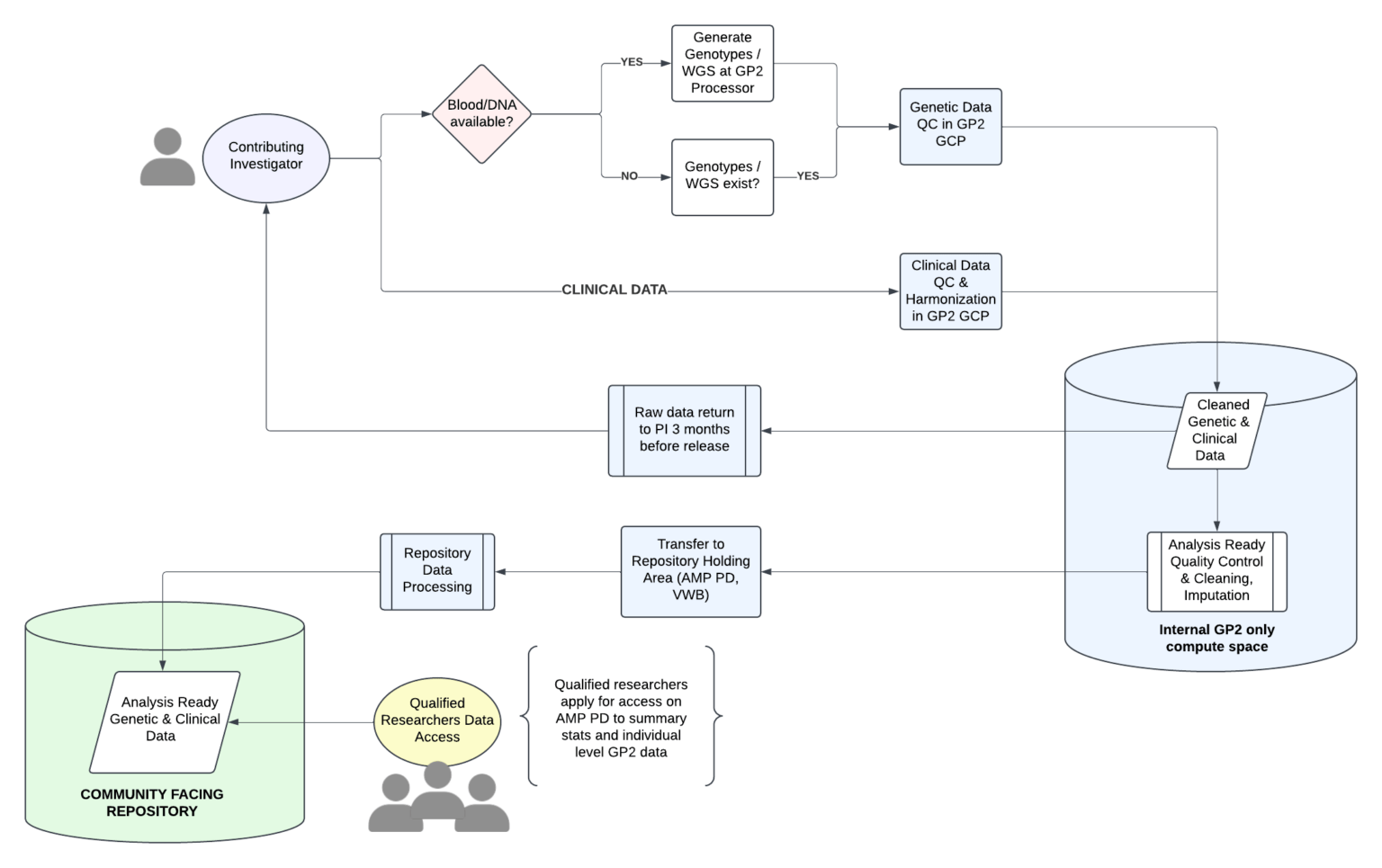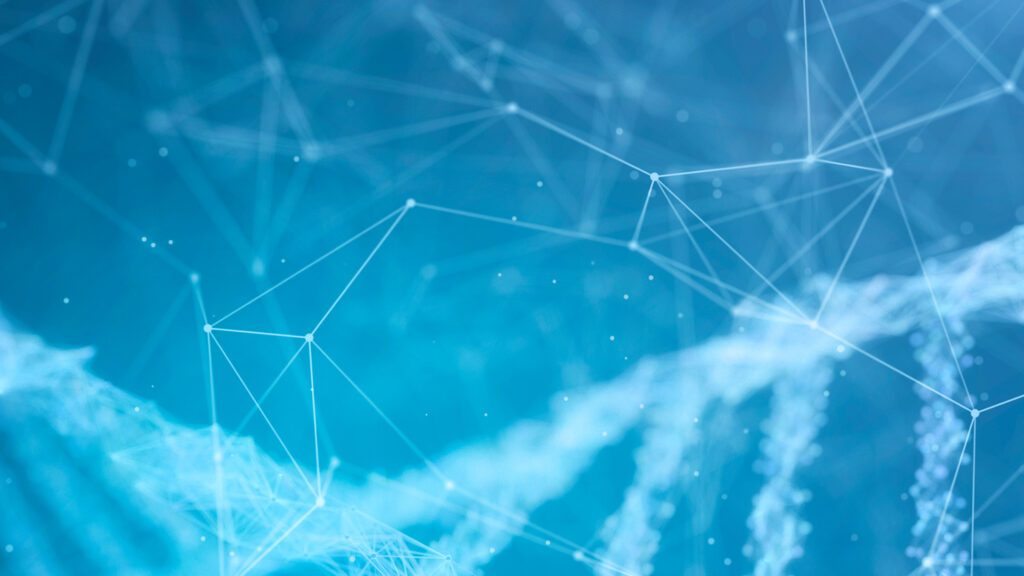An essential part of the Global Parkinson’s Genetics Program (GP2) is the creation of a global community of researchers committed to making transformative advances in Parkinson’s disease research. To be successful, this community will have to work together efficiently and with minimal barriers to progress. This will require each investigator to have a clear understanding of GP2’s goals, the central tenets underlying the achievement of these goals, and trust. In order to facilitate these goals, we describe the code of conduct for investigators in GP2. This document is not a legal framework, rather, it is a document that outlines the general principles of GP2 with the understanding that investigators will adhere to the spirit of these principles and, if in doubt, that they will ask for guidance.
The core principles of GP2 include:
- GP2 and the researchers within it will operate transparently with a goal of no surprises
- GP2 and its researchers will focus not on what is best for GP2 or the individual researcher, but for the overall research/patient community
- GP2 researchers will collaborate in an environment of honesty, fairness, and trust – GP2 and its members will promote early-career researchers
- GP2 members will treat one another and members of the clinical, scientific, and patient/participant community, with respect and professionalism
- GP2 and its members will promote researchers from underrepresented populations
- GP2 and its members will respect other groups’ data and autonomy
- GP2 members will not share nonpublic GP2 data/results with other parties without permission
- Outside of the GP2 analytical space GP2 members will never share or work on individual-level GP2 data outside of data generated in their own samples without express permission
Data Sharing
A key underlying principle of GP2 is that the data generated by and associated with this effort should be made accessible to the research community. At its most fundamental level, this requires data sharing, and indeed this is a requirement for GP2 involvement. This principle extends beyond simple sharing to include making the data available in a way that supports analysis, collaboration, and scientific progress by technical and non-technical users.
Following data generation and initial quality control, GP2 data will be returned directly to the cohort submitter. Following complete quality control and data processing, data will be positioned in community-facing platforms for data sharing (for example AMP PD, https://amp-pd.org/). A requirement then is for each participating center/investigator to agree to share raw data with the GP2 collaborative group, which will be part of the Contributing Cohort Collaboration Agreement and the Material/Data Transfer Agreements (MTA/DTA).
A further requirement will be for centers/investigators to share summary results from these data, without restriction, to the broader research community and to share raw data with appropriate agreements administered through the data portal (for example AMP PD) to bonafide, qualifying researchers. This flow of data is designed to make critical data available to the research community as quickly and easily as possible. We recognize that this is not without perceived risk and in particular, that researchers may be concerned about giving away their data, losing their intellectual input, or losing their competitive advantage.
We believe, however, that the advantages for the community and the contributing researcher outweigh these risks substantially. In hand with this access are the computational resources and expertise within GP2 to support proposed analyses, and access to the GP2 community to perform additional coordinated analyses, including those immediately outside of the GP2 primary aims.
Any contributing investigator/site will have their data returned to them immediately and retain the autonomy to use these data to address their own research questions. We encourage GP2 members to propose and lead analyses, to leverage GP2 data to ask questions, including those outside of GP2’s initial remit, and to be active collaborators in core analyses. GP2 is committed to providing training and opportunities for motivated individuals to work with these data.
In order to maintain transparency and efficiency, GP2 has a no surprises policy. Investigators are encouraged to explore GP2 data, but at the earliest point that this exploration progresses toward asking bonafide research questions, the investigator(s) should declare the scope of this question to GP2, which will be shared with GP2 investigators. This has the advantage of minimizing internal competition, reducing the inefficiency of redundant work, and creating a shared intellectual space where collaborations can be formed between scientists with overlapping interests and data.
Use of GP2 Data Through Data Release on Access Controlled Repository
GP2 data should be considered as confidential information and is only accessible to vetted researchers. There are two primary access points to these data (see Figure 1):
First: cleaned, quality-controlled, and harmonized data for a submitted sample/data set will be returned directly to the contributing investigator. The investigator has complete autonomy to ask any and all research questions on the data generated from their contributed samples.
Second: once full quality control and data processing have been completed it will be available to bona fide researchers through a suitable access-controlled repository (for example AMP PD). In this scenario, GP2 data will be freely accessible to all researchers with a valid data use application and can be used for research purposes only.

Figure 1: Schematic representation of GP2 data flow from contributing investigator to qualified external researcher access.
Proposing and Pursuing Work in GP2
At any point GP2 investigators are free to propose novel data collection, data generation, and analytical strategies. GP2 has some resources to support additional work and would strongly encourage investigators to propose additional efforts. GP2 also encourages members to explore leveraging GP2 data and structure to garner support for work outside of GP2’s immediate scope. Proposed analyses using GP2 data should be submitted to the Project Proposal Working Group.
Analyses, Code, and Publication
The publication and code sharing policies are outlined in separate agreements, however we describe the general principles here. We envisage three classes of work derived from GP2 data:
First, analyses using GP2 generated data returned to a single contributing investigator or site. The investigator is free to use these data as they see fit. We encourage and will support the open sharing of code and results from this work. This work does not require approval from GP2, however, should it be published we would ask that the manuscript should be shared with GP2 when written and seven days prior to submission to a preprint server and journal for standard review.
Second, GP2 supported work, this can essentially be considered GP2 driven pieces of work. GP2 and its members are participants and authors, either as individual authors and/or under a banner GP2 authorship. GP2 leadership has oversight of and responsibility for this work and the content of these manuscripts. We will create a tracking document that will include these core projects, the leads, and participants. This list is not intended to limit analyses or participation but rather reduce redundancy in effort and analyses.
Third, work by investigators external to GP2 who have accessed GP2 data through data release in the controlled access portal. In this instance GP2 may be invited to be participants in the work and banner authors, but this is not a requirement. We will ask for acknowledgement of GP2 in any manuscript or presentation of these data.
While we believe that these cover most circumstances we recognize that there are always exceptions and would ask that the investigators ask GP2 for clarification on any of these points if unsure of how to proceed in alignment with the spirit of this agreement.
Using AI to Review GP2 Documents
The below text applies when GP2 members want to use AI tools/services to review internal and unpublished documents and specifically applies to all GP2 documents that are not in the public domain, for example: manuscript drafts that have been shared with the GP2 community but have not yet been deposited as a preprint or published. As a reminder, GP2 community review of publications is an important GP2 activity, and we would encourage reviewers to make constructive comments and suggestions.
- You may not enter the contents of these documents into generative AI tools/services that (i) (potentially) share the queried text externally or (ii) use this text for model training and learning. GP2 allows the use of AI that does not store or share data beyond the user account. Note that you are responsible for reviewing up-to-date policies from the AI software you use to ensure they are in alignment with this policy. For example, as of April 2025, the free version of ChatGPT is not compliant.
- When using AI tools/services that are compliant with the above point, to review, provide feedback on, or summarize GP2 documents that are not in the public domain (including unpublished manuscripts), you must disclose this use in the document you are commenting on. For example, add in the comment to the document:
- “Hello my name is <add in your name and affiliation>, during the review of this document I used <add in the name of the AI tool you used> AI tools/services to help give feedback. I certify that the AI tool/service I used is privacy-preserving and that I reviewed and approved all comments before adding them to the document.”
Removal from GP2
We expect GP2 members to abide by the general principles of rigor, respect, and responsibility. Egregiously poor or purposefully misleading scientific work, a failure to abide by the GP2 code of conduct or its spirit, or irresponsibility in dealing with GP2 data will all be grounds for removal from GP2. Any adverse or unacceptable behavior that does not align with GP2 Core Principles (e.g. bullying, harassment, inappropriate words or actions) may be reported directly to the GP2 leadership or via [[email protected]]. All complaints will be reviewed and investigated promptly and fairly. A decision to remove a member would not be made lightly and would require discussion and recommendation by the Steering Committee of GP2.
